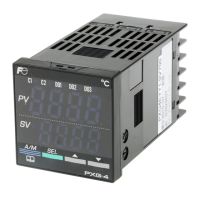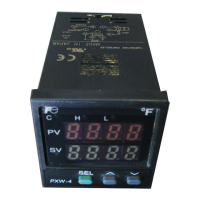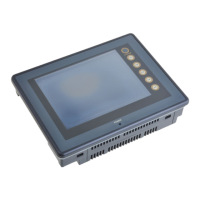20
Integral Time
With the proportional band alone, the process tends to reach equilib-
rium at some point away from the main setpoint. This offset is due to
the difference between the output needed to maintain setpoint and
the output of the proportional band at setpoint. SInce the proportional
band is equidistant from the main setpoint, the output is around 50%.
If anything more or less than 50% output is required to maintain set-
point, an offset error will occur. Integral action eliminates this offset.
See the diagrams below.
Integral action eliminates offset by adding to or subtracting from the
output of the proportional action alone. This increase or decrease in
output corrects for offset error within the proportional band in estab-
lishing steady-state performance at setpoint. It is not intended to cor-
rect for process disturbances. See the following diagram.
Integral Time is the speed at which the controller corrects for offset.
A short integral time means the controller corrects for offset quickly.
If the integral time is too short, the controller would react before the
effects of previous output shifts–due to lead or lag time– could be
sensed, causing oscillation. A long Integral time means the control
corrects for offset over a long time. If the integral time is too long, the
offset will remain for some time causing a slow responding or slug-
gish control. See the diagram below.
Derivative Time
In the case of a process upset, proportional only or proportional-inte-
gral action cannot react fast enough in returning a process back to
setpoint without overshoot. The derivative action corrects for distur-
bances providing sudden shifts in output which oppose the diver-
gence of the process from setpoint. See the diagram below.
The derivative action changes the rate of reset or integration propor-
tional to the rate of change and lag time of the system. By calculating
the rate of change of the process and multiplying it by the lag time
which is the time it takes the controller to sense an output change,
the controller can anticipate where the process should be and
change the output accordingly. This anticipatory action speeds up and
slows down the effect of proportional only and proportional-integral
actions to return a process to setpoint as quickly as possible with
minimum overshoot. See the diagram below.
Derivative time is the amount of anticipatory action needed to return a
process back to setpoint. A short derivative time means little deriva-
tive action. If the derivative time is too short, the controller would not
react quickly to process disturbances. A long derivative time means
more derivative action. If the derivative time is too large, the con-
troller would react too dramatically to process disturbances creating
rapid process oscillation. A process which is very dynamic such as
pressure and flow applications is more efficiently controlled if the
derivative action is turned off because of the oscillation problem
which would result.
Tuning
Tuning, as with any PID loop, requires tuning each parameter sepa-
rately and in sequence. To achieve good PID control manually, you
can use the trial and error method explained below.
Tune the Proportional Band
Set Integral Time = 0 (off)
Set Derivative Time = 0 (off)
Start with a large Proportional Band value which gives very sluggish
control with noticeable offset and tighten by decreasing the value in
half. Analyze the process variable. If the control is still sluggish, tight-
en by decreasing the value in half again. Continue with the same pro-
cedure until the process starts to oscillate at a constant rate. Widen
the Proportional Band by 50%, or multiply the setting 1.5 times. From a
cold start, test and verify that the Proportional Band allows maximum
rise to setpoint while maintaining minimum overshoot and offset. If not
completely satisfied, fine-tune the value, up or down, as needed and
test until correct. The Proportional Band is now tuned.
Add Integral Time
Start with a large Integral Time value which gives very sluggish
response to process offset and tighten by decreasing the value in
half. Analyze the process variable. If the response to process offset is
still sluggish, tighten by decreasing the value in half again. Continue
with the same procedure until the process starts to oscillate at a con-
stant rate. Increase the Integral Time value by 50%, or multiply the
setting 1.5 times. From a cold start, test and verify that the Integral
Time allows maximum elimination of offset with minimum overshoot. If
not completely satisfied, fine-tune the value, up or down, as needed
and test until correct. The Integral Time is now tuned.

